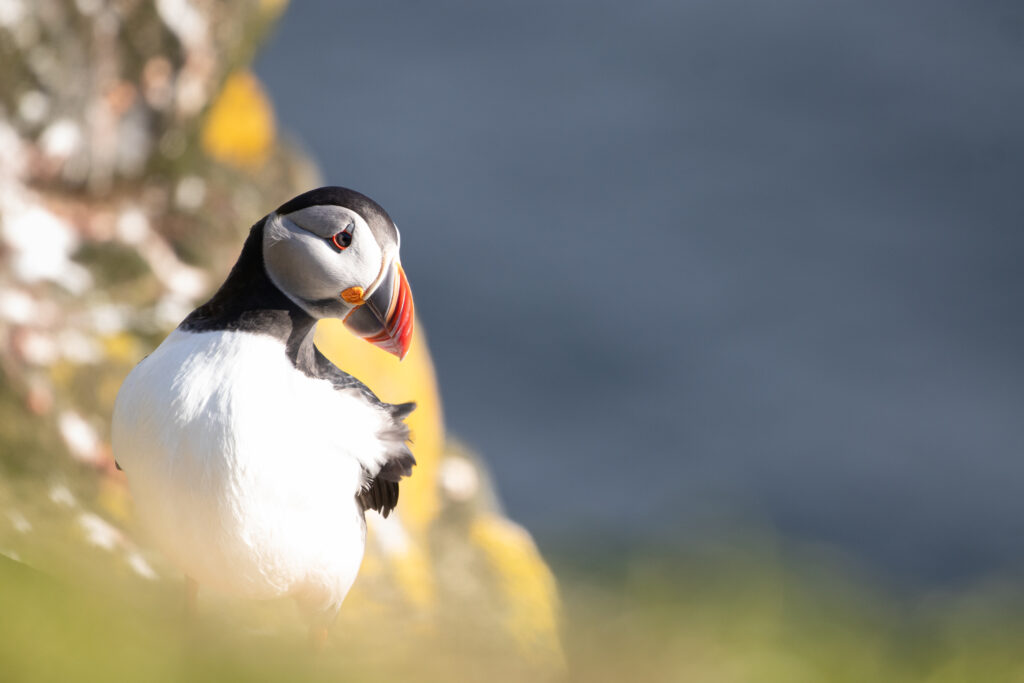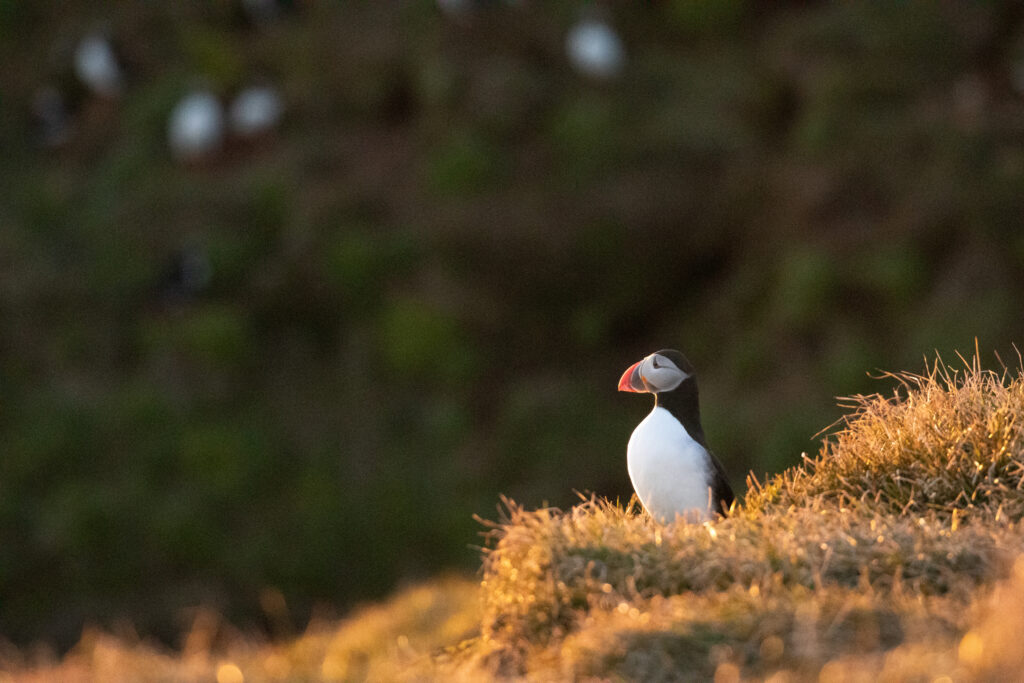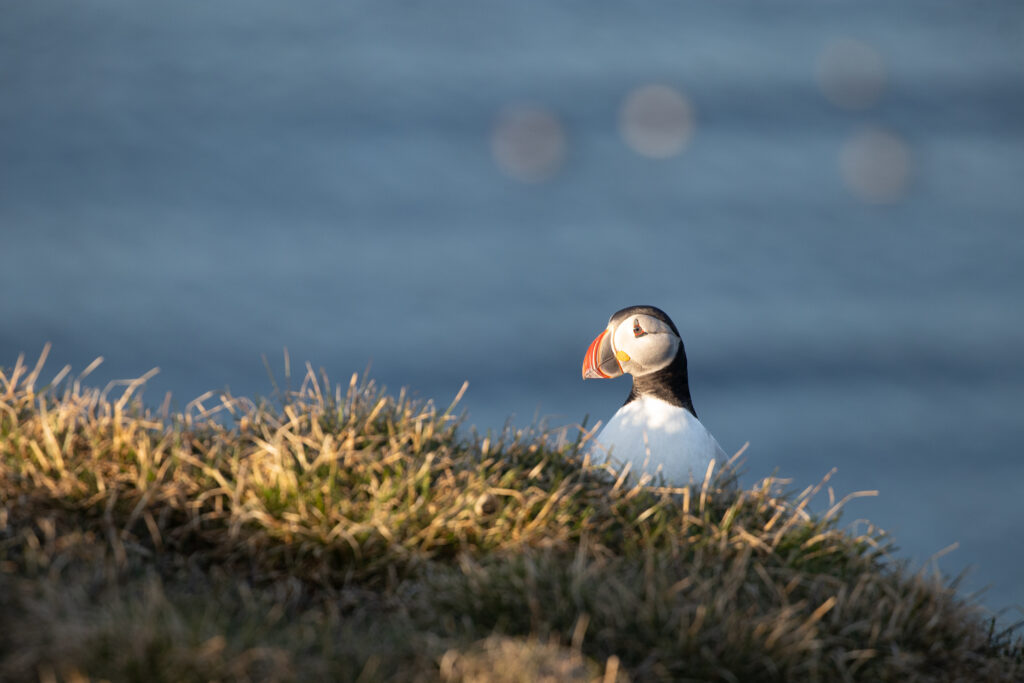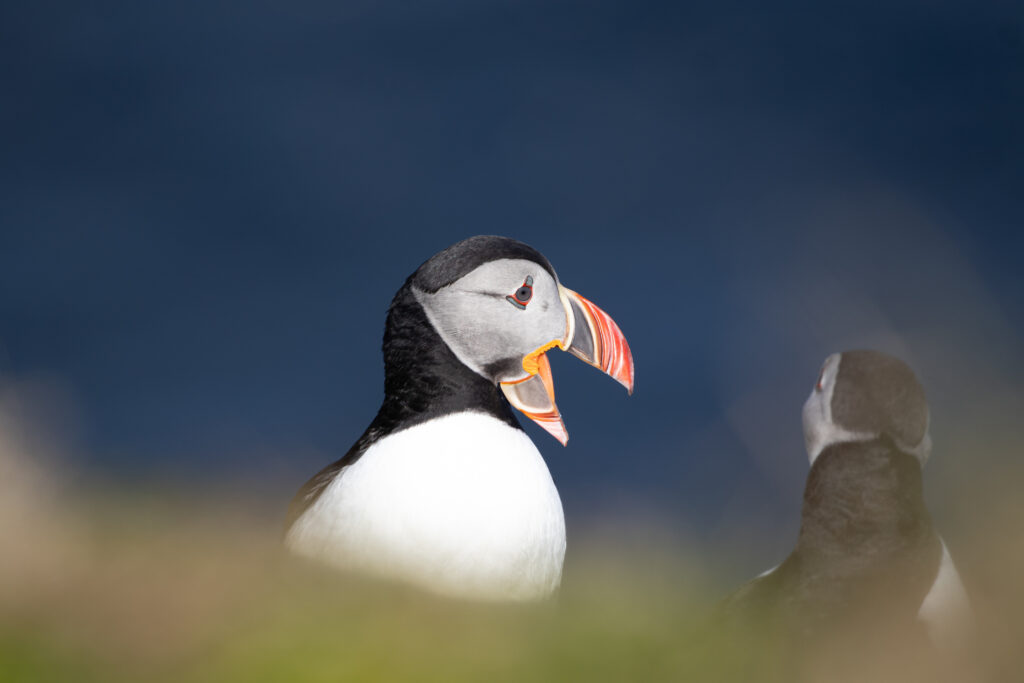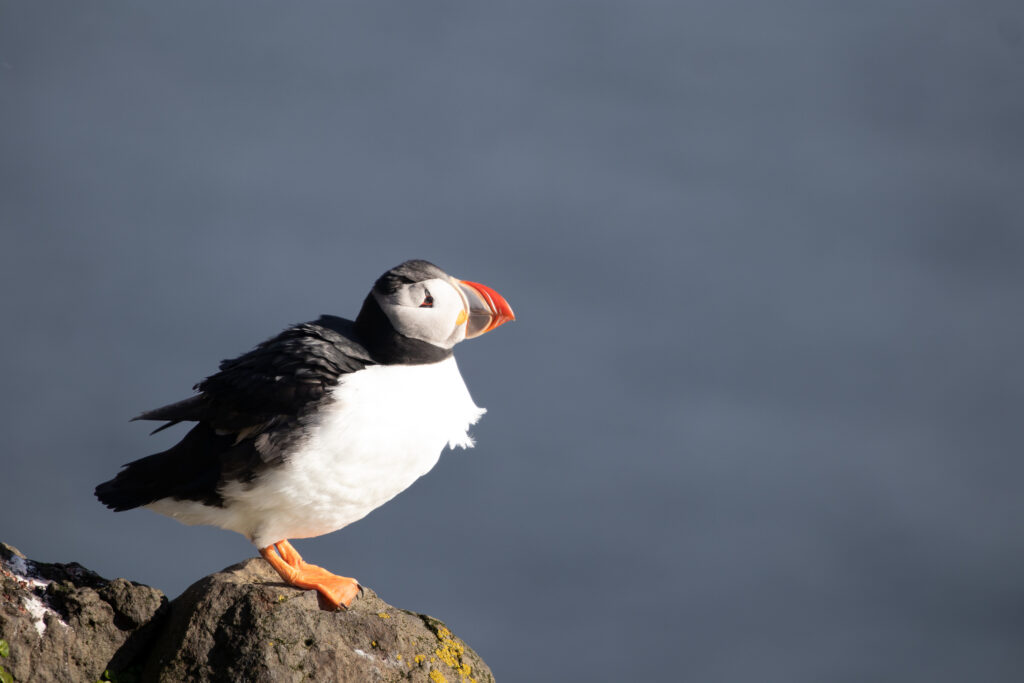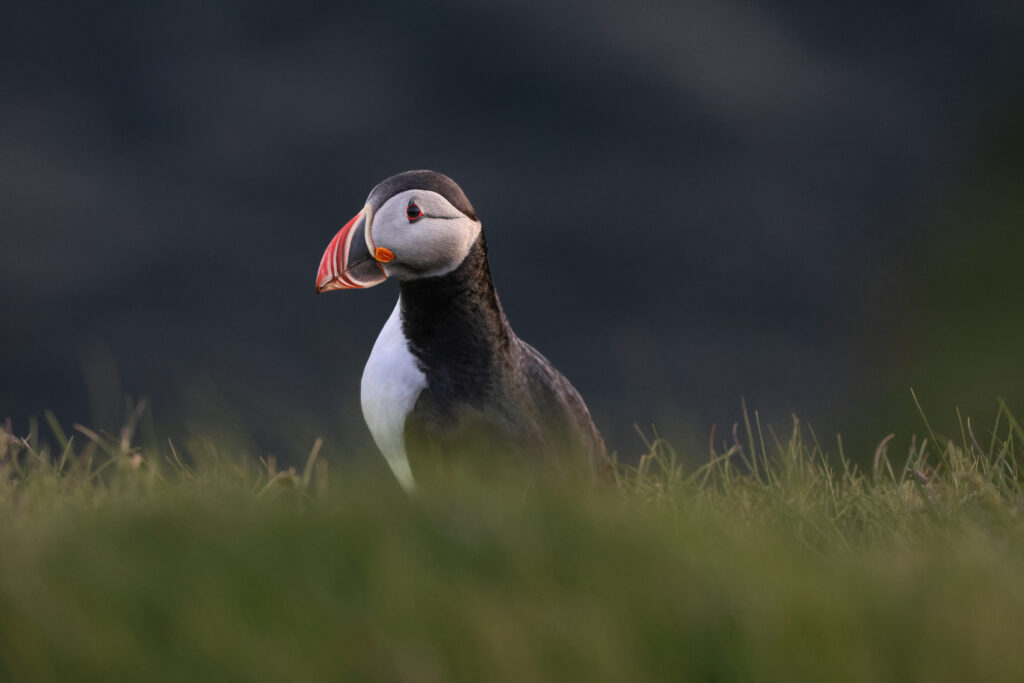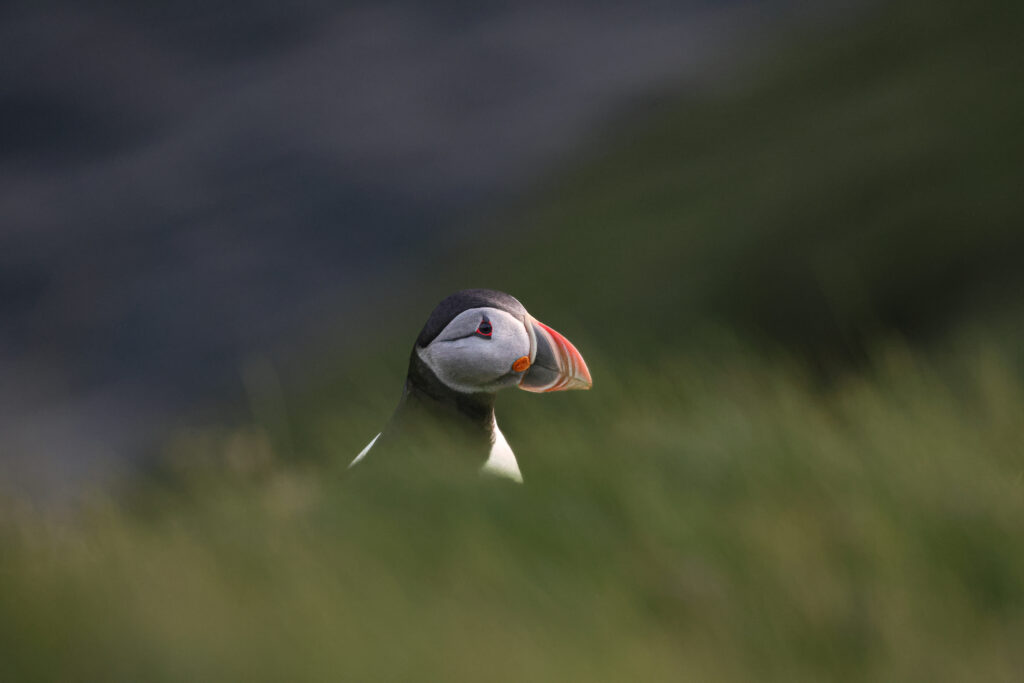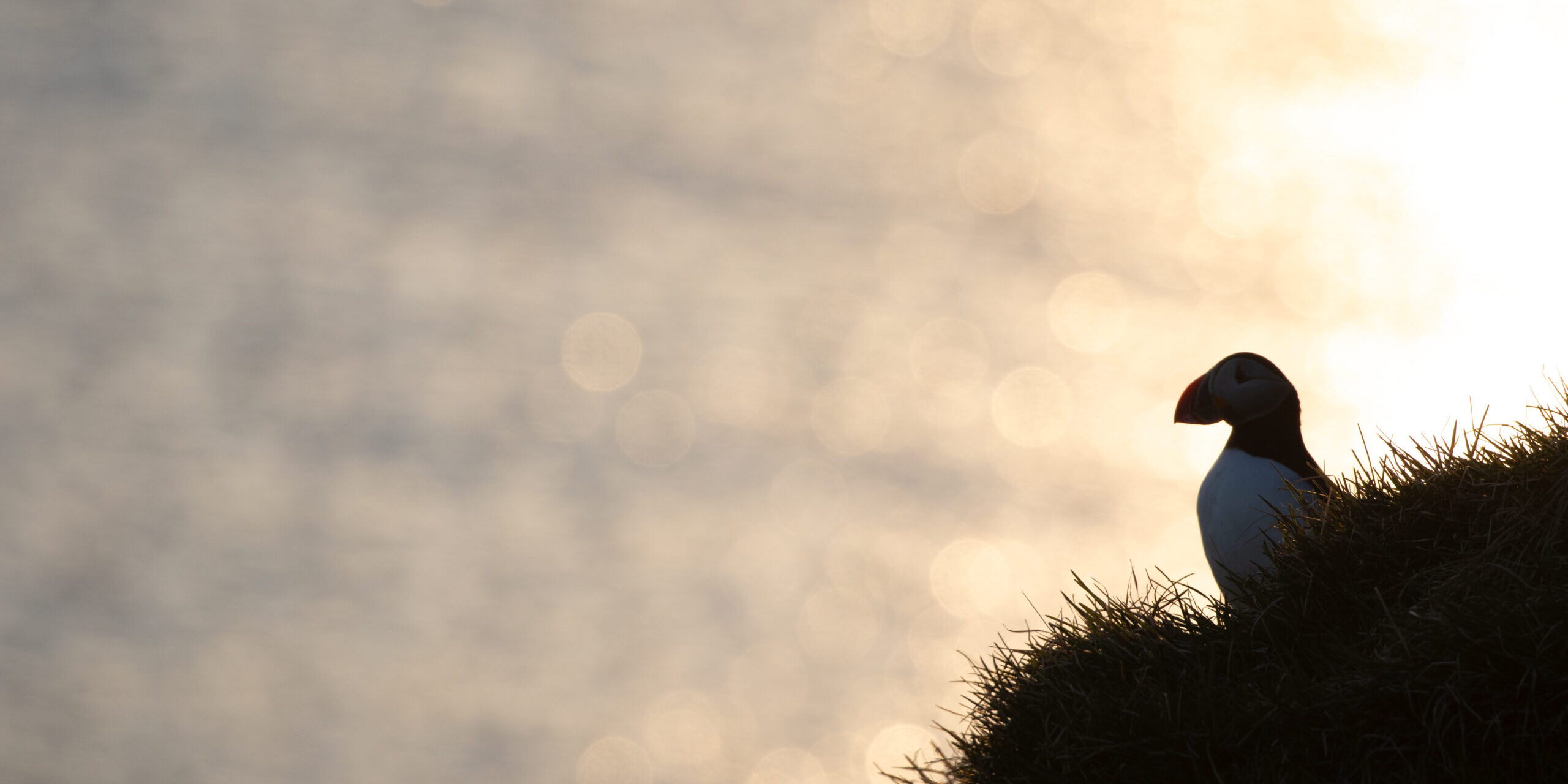The fate of the Atlantic puffin is up to us
My breath formed on the ferry window as I pressed my face into it. The last Atlantic puffin I would see this year skimmed the surface of the break, its wings beating with full effort. My eyes followed him, desperate to keep his little body in sight as long as possible. Despite the distance between us, I felt so close. The time spent observing the colony on Vestmannaeryjar took residence in my heart. Over the course of three days the birds had grown used to me, often getting too close for photographs, but close enough for a real connection. I wondered if they remembered the lady with the long camera from last year, always arriving pre-dawn and then again at sunset.
Would I ever see them again?
I hated the sound of the boat’s engine. Its consistent drone reminded me of the return sail from this magical island. I hated the stale air and the hard leather seat. I wished I were back at Storhöfði, nestled inside my crook of wet grass beside the cliffs; my only soundtrack was the crashing waves and laughing fulmars, so engrossed, I didn’t notice I was lying in sheep shit.
It felt ridiculous, crying over puffins. Then I realized these were the moments we needed to pay attention to; when the heart spoke.
The Atlantic Puffin
The Atlantic puffin is a symbol of Iceland, delighting visitors, drawing photographers, and bird enthusiasts from all over the world. There is not a single tourist shop without puffin keepsakes, and one look at this charming bird will win your heart forever.
I remember the first time I saw a puffin. It was during a camper van trip in July of 2021 at one of Iceland’s popular puffin spotting spots, Dyrhólaey on the south coast. The little sea bird with a big personality came in for an uncertain landing in the grass beside the cliffs. If you have ever seen a puffin land or take off, you can understand what I mean. They look like, well, that they might not make it!
Fun puffin fact: Puffins are superb divers, using their wings to propel themselves up to 200 feet when they dive for fish! They can stay submerged up to one minute!
I fell instantly in love with them and was able to return a few more times for puffin season, even journeying to the remote island of Grimsey to photograph them this April. During this trip, the puffins were reunited with their mates for breeding season, and I was able to observe “billing,” an adorable courtship ritual where puffins rub their beaks together.
The Atlantic puffin chooses a mate for life, but despite their faithfulness, most of their lives are spent at sea alone, until April when they reunite for the breeding season, which lasts until mid-August.
Puffin population is on the decline
For the last two summers, I have spent a week on the Westman Islands in Iceland photographing one of the largest puffin colonies in the world. Last summer, I would hike to Storhöfði, a cliff where puffins are known to nest. After setting up at a respectable distance from the colony, I would wait for the puffins to arrive. This year, I noted a significant drop in puffin sightings in the same spot and time as last year. A few photographers would show up, hang out for a while, shrug, and then leave because of the lack of subjects to photograph.
In April, I witnessed puffin hunting by foreigners on Grimsey, which is legal with the proper licenses and a local guide. Although Grimsey is a small island, I was not the only visitor that day who saw this, and everyone was equally disturbed, considering how popular Grimsey is for puffin tourism and knowing they can’t export the puffin meat. This was just for sport.
Perhaps my observations are a coincidence or a fluke, but it prompted me to research the Atlantic puffin, and what I found out was both disturbing and shocking.
In 2024, there is an estimated 7-8 million adult puffin population 2024 with a decline, particularly in the northeast Atlantic. Iceland is home to the world’s largest puffin population, and together with Norway, it makes up 80% of the world’s puffin population.
The puffin population in Iceland and Norway combined is 80% of the world’s population. Most of Iceland’s puffins are located on the Westman Islands, home to the world’s arguably largest puffin colony with an estimated 1 million puffins. Vestmannaeyjar, or Westman, is a volcanic archipelago located off Iceland’s south coast. It is reachable by a 40-minute ferry ride from Landeyhöfn and often overlooked by mainstay tourism, making it a prime spot for puffins and nature lovers to visit in the summer months.
These may seem like large numbers, but the rapid decline is most concerning. The Atlantic puffin is now classified as vulnerable by the International Union for Conservation of Nature. Although puffins are not yet endangered, their numbers are declining primarily due to the following:
Climate change. The temperatures of our oceans are rising, meaning puffins have to fly further out to sea to hunt for their food, such as sand eels and herring.
Overfishing. One of the puffin’s primary sources of food, the herring, has suffered a massive population decline due to overfishing and habitat loss.
Loss of habitat. Like most of our shorebirds, puffins are suffering from overdevelopment of shorelines and areas where they breed. Even the light pollution of nearby towns is a detriment to the puffins when their young fledge the nest. Pufflings navigate by stars and the moon and sometimes mistake artificial light for their compass. In August, locals on Westman host a puffling patrol, where they collect confused pufflings in town at night and help them return to the sea the next morning!
Pollution. It is estimated that there are trillions of microplastics in the world’s oceans. In June, I observed a baby Oystercatcher feeding with its parents on the shoreline. These areas are critical for shorebirds as well as the cleanliness of the oceans where they feed. Ingestion of microplastics is an unfortunate fate for pufflings and other shorebirds.
Hunting. Although Iceland has strict laws in place regarding puffin hunting, it still exists, and puffin meat remains on the menu of a few restaurants. At one point in time, puffin meat was a critical source of food for Icelanders. However now. It is not necessary to survive; it remains only due to its cultural significance and as a menu item for poorly informed tourists, much like whale meat. Most Icelanders I have spoken with do not support puffin hunting and do not eat puffin meat.
It is unclear what the BIGGEST contributing factor is to the decline. Perhaps hunting plays only a minor role; however, considering their vulnerable status, every effort should be made to protect them.
Additionally, puffins mate for life and only have one egg, making their species even more vulnerable to population loss.
Here in the USA, the Atlantic Puffin is protected in the US by the Migratory Bird Act, and they cannot be hunted, trapped, or killed. However, the Atlantic puffin is not protected in Iceland. Furthermore, puffins only have one egg per breeding season, adding to the vulnerability of the species.
Puffin hunting
Although laws restrict the exploitation and overhunting of puffins, the Icelandic government is taking a closer look at changing this due to the declining numbers of puffins, even pushing to have puffin meat removed from menus.
- Iceland and the Faroes are one of the few places in the world where puffin hunting is still permitted.
- Puffin hunting is a long-standing tradition as a food source in regions with scarce options.
- Puffin hunting is typically done using a large net on a pole, a technique called “sky fishing,” to catch the birds in flight.
Puffin hunting in Iceland is now regulated; however, puffin meat remains on the menus in some popular restaurants in Reykjavik and throughout the country. Despite hunting having cultural significance (much like whale hunting), this practice has become controversial due to the population decline. Conservationists and organizations are advocating for a complete ban on puffin hunting and the sale of puffin meat to tourists.
How can you help save the puffins
You may be a tourist considering a visit to Iceland, a prior visitor, or an Icelander. Regardless, there are ways anyone can help make a difference in the future of the beloved Atlantic puffin
Adopt a puffin through the Beluga Whale Sanctuary operated by Sea Life Trust.
Do not order puffin meat in Iceland or better yet, do not visit restaurants that serve puffin on the menu.
Share any photos of puffins you took and your enthusiasm for them. The more Iceland understands how precious these birds are for tourism, the better.
Support puffin tourism! Much like whale watching tours support whales by educating the public and demonstrating value to the government by generating revenue, so will puffin tourism! Visit places like Westman and Grimsey in the summer months to puffin watch or book a puffin tour! Companies like North Sailing offer a classic Whale and Puffins Tour in the summer months.
Support sustainable tourism by booking tours with companies that prioritize wildlife conservation and responsible wildlife viewing.
Support organizations that advocate for cleaner oceans and puffin conservation.
Join the puffling patrol in mid-August on Westman, where locals collect lost pufflings and return them to sea! This is a hands-on opportunity to help puffins with locals. Take the ferry to Westman in mid to late August and seek out the locals looking for pufflings! This is usually done at night, and you can spot them by who is wandering around with a cardboard box. The people of Westman are very friendly, or you can head to the Beluga Sanctuary that features Iceland’s only puffin rescue and ask how you can get involved. This is a fun family activity for any puffin lover!
Volunteer for a beach cleanup! An organization in Iceland called “the Blue Army” would be delighted to have you join for a beach cleanup day!
Respect the wildlife. When viewing puffin, read the cues. If the puffins appear disturbed, give them more space. It is always best to observe wildlife, especially during breeding season, from a safe distance. Allow them to do their puffin things, and maybe they will get closer on their own!
No matter where you live, you can help make a difference for our shorebirds, oceans, and our planet by participating in recycling programs, participating in a beach cleanup, advocating for our oceans, or supporting organizations that protect our oceans. There are local programs in the USA, such as The Puffin Project, which is part of the Seabird Institute in Maine. For August, any profits from my puffin prints go to this organization to help in conservation efforts. You can see the prints here in my shop.
Best places for puffin viewing in Iceland:
Grimsey Island
Westman Island
Dyrholaey on the south coast
Latraberg in the West Fjords
Borgarfjörður eystri in the East Fjords
Share your puffin stories with me!
